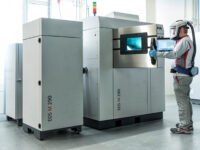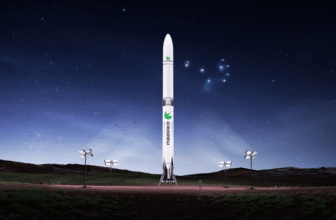
Talent Needed: EOS’s Alefeld & the US Navy’s Rettaliata Discuss Why They’re Teaming Up to Train the 3D Printing Workforce – 3DPrint.com
No amount of attention that the additive manufacturing (AM) industry devoted to the challenge of workforce development could be considered “too much” these days. Nowhere is this truer, perhaps, than in the US, which already has almost half a million open manufacturing jobs at a time when the nation is attempting to ramp up its generational effort to reshore supply chains.
During the last few years, two organizations have stood out in their efforts to accelerate the development of the American AM workforce: EOS and the US Navy. Via its Additive Minds Academy, EOS has worked tirelessly to streamline the training process required to bring new AM workers into the fold, an endeavor enhanced by the company’s opening of a physical training facility last year at its North American headquarters in Novi, Michigan. And the US Navy’s Maritime Industrial Base (MIB) Program has utilized wide-ranging, novel methods for bringing awareness to the looming US manufacturing labor shortage, while simultaneously investing substantial resources to establish the educational system necessary to address this shortage.
It is quite fitting that EOS and the US Navy have come together to jointly create a training program that teaches workers at MIB suppliers how to produce parts using laser powder bed fusion (LPBF). Through a BlueForge Alliance contract, the Navy and Additive Minds Academy are now training MIB contractor employees — free of charge — in the EOS LPBF ecosystem.
According to Fabian Alefeld, EOS Global Director of Business Development and Additive Minds Academy, EOS’s obsession with developing the AM labor pool is a matter of sheer necessity:
“We believe that in order to grow the AM market, we need to grow the workforce,” Alefeld began. “Considering how rapidly evolving the technological field is, we are actually forced into a position where we have no choice but to educate the user-base. So, from both selfless and self-interested perspectives, we need to ensure that engineers, technicians, machine operators, and everyone else in the AM workforce have the tools they need in order to push the technology to its limits.
“That is at the heart of why we started Additive Minds ten years ago, it’s why we started the Additive Minds Academy a few years ago, and it’s also why, today, we’re so proud and excited to help grow the AM capacity for the Maritime Industrial Base.”
Dr. Justin Rettaliata is the MIB Program AM Program Manager at Naval Sea Systems Command (NAVSEA), which oversees ship design, engineering, and logistics for the US Navy. He views AM training programs as a vital component in a broader national effort to create as many new manufacturing workers as possible for the companies responsible for building the US military’s maritime weapons systems:
“From the Navy’s perspective, workforce development has been a very important element to different lines of effort that we’ve cultivated for the Maritime Industrial Base Program. It’s not just AM, it requires looking across all the various industrial supports that we need in order to produce equipment for the US Navy,” Rettaliata explained. “This is why we have our partnership with the Accelerated Training in Defense Manufacturing (ATDM) program in Danville, VA, for instance, where we also have our Center of Excellence.”
ATDM is a Navy-funded workforce development initiative that supports multiple critical trade pipelines.
“In addition to AM, the ATDM trains CNC machinists, welders, as well as workers in non-destructive testing and metrology. The partnership with Additive Minds Academy is another avenue to help us expand this same mission. As we focus more and more on partnerships with OEMs and other players in private industry — and, in turn, as we start bringing more new equipment into the infrastructure that our supply chains depend on — we need to devote just as much of our focus on ensuring that there’s a workforce that can operate that equipment.”
Yet, at the same time as AM is just one amongst a wide range of technologies required to reshore US shipbuilding capacity, the potential for AM — and metal AM, in particular — to enable production of components without a reliance on tooling does put a special emphasis on the role of LPBF in the overall reshoring effort:
“We’ve had a lot of demonstrations with metal AM related to some of our parts that have low production volumes and long lead times, and we’ve shown that we can knock those lead times down considerably with the use of AM,” said Rettaliata. “Beyond that, the ability to manufacture without being constrained by tooling and fixtures will allow us to broaden our manufacturing ecosystem. I think that it will provide an opportunity for the Navy to implement distributed production capabilities into our supply chain.
“That could help shorten the production timeline when it comes to ship construction, but it also has the potential to improve our fleet readiness, in terms of our effectiveness at maintenance. There’s an enormous increase in flexibility that comes with being able to replace a piece of a part, for instance, versus having to replace the entire part. And ultimately, since we won’t be as beholden to single source suppliers, metal AM can have a real impact on the Maritime Industrial Base’s supply chain resilience.”
Of course, again, none of that is possible without the workers who can operate the machines. When I last talked to Alefeld, he explained that the relationship between reshoring and the manufacturing worker shortage is a classic chicken-or-the-egg scenario: “If we want to bring back manufacturing, who’s supposed to make the parts?”
That problem has risen far closer to the surface in recent months, and its ability to undermine the US’s attempts to revitalize its manufacturing landscape should only become more apparent in the years ahead. On the other hand, the Additive Minds Academy is a viable solution that actually exists and can be scaled up. Most importantly, it’s fast, and the program designed for the Navy is even faster:
“The Navy program is very condensed,” Alefeld described. “We’re trying to enable engineers, technicians, or really anyone who is trying to figure out how to implement AM. We’re enabling people, in a very short period of time, to understand the full LPBF process chain, and to execute that knowledge. At the end of the program, participants get an official ASTM certification, so whoever goes through the training is ready to hit the ground running once they’ve completed it.
“You don’t need a PhD to run these machines like you used to 15 to 20 years ago. On a weekly basis, we train people how to operate industrial AM systems in about three days. What we’re doing with the workers that we train is making sure they get a few builds under their belt to create that muscle memory, certifying them, and getting them back to work at their maritime supplier.”
Anyone qualified and interested in joining the Additive Minds Academy/Navy training program can sign up here. This includes anyone working for a company that supplies parts to the US MIB, ranging from existing machine operators to AM production managers to people with no experience with AM at all.
“Expanding the pool of skilled workers will help lower the barrier to entry in AM across all applications,” Dr. Rettaliata summed up. “It also supports a more resilient, responsive defense industrial base, which benefits not just the Navy, but the entire U.S. military.”
Images courtesy of EOS.
Subscribe to Our Email Newsletter
Stay up-to-date on all the latest news from the 3D printing industry and receive information and offers from third party vendors.











